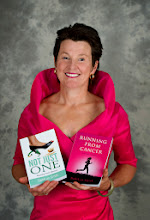This week's food blog is: "D" is for Dairy:
To eat dairy products or not is such a huge debate between health food magazines and dairy farmers. When I found out I had breast cancer, the nutritionist advised I skip the 4 glasses of skim a day and try to avoid dairy products. He said there were dangerous growth hormones and antibiotics in milk and so, sadly I took up the torturous path of trying to find substitute rice and soy cheeses. Suffice to say they all tasted like ...well, not like cheese to say the least!
Recently, Cracker Barrel cheese has been running commercials that state their products are hormone and anti-biotic free because they are made from good old Canadian cows. What the heck did that mean and how did it affect me, I wondered.
When it comes to dairy and breast cancer, be grateful that you live in a country as health conscious as Canada instead of in the United States where manufactured hormones may have been injected into the cow.
Dairy cows in the rest of the world (except EU, Canada, Japan, Australia and New Zealand) are allowed to inject their cows with a recombinant Bovine Growth Hormone (rBGH) which stimulates growth production up to 10 times the normal rate.. The use of this hormone causes a large upsurge in udder mastitis and lameness which means antibiotics also have to be used on the cows.
But by far the largest controversy is the milk from cows that have been injected with genetically engineered rBGH which contains 2 to 10 times IGF-1 (insulin-like growth factor) than normal cow's milk. This is significant, because studies have found the risk of prostate cancer for men over 60 years of age with high levels of IGF-1 to be eight times greater than for men with low levels. And the risk of breast cancer for premenopausal women with increased blood levels of IGF-1 to be up to seven times greater.
Consultants paid by Monsanto, the rBGH manufacturer, say that milk from injected cows is absolutely safe for human consumption because IGF-1 is destroyed by pasteurization. FDA researchers, on the other hand, report that IGF-1 is not destroyed by pasteurization.
Monsanto also says the hormone is safe because IGF-1 is completely broken down by digestive enzymes and does not enter the human intestinal tract. But researchers not paid by Monsanto say that IGF-1 may not be totally digested, and that some does make its way into the colon and cross the intestinal wall into the bloodstream.
Monsanto also says the hormone is safe because IGF-1 is completely broken down by digestive enzymes and does not enter the human intestinal tract. But researchers not paid by Monsanto say that IGF-1 may not be totally digested, and that some does make its way into the colon and cross the intestinal wall into the bloodstream.
So I am glad to say that I am a proud Canadian and back to eating a bit of cheese, yogurt and sour cream (if they have been made from good old Canadian cows). I'm still using almond milk on my morning oatmeal though because if you have read any of the Health Food magazines, they say that drinking any milk from an animal just isn't a natural thing to do. When you think about it, what other animal continues to consume milk long after infancy? Not only milk, but milk intended for babies of that species?
Like everything else in life, I think the key is moderation. Unless you are lactose intolerant, some dairy in your life is probably not going to harm you. Drinking gallons of milk a day might not be advisable- growth hormones or not.


